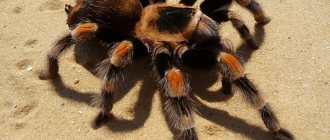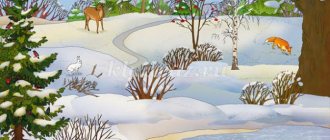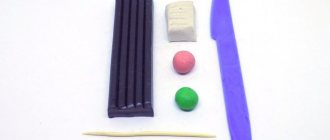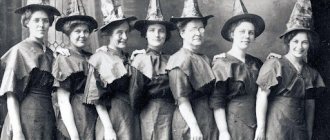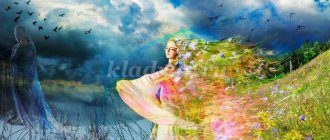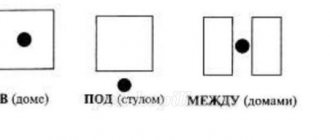Journey into the animal world – wild animals
Approximate plan - summary of GCD for cognitive and research activities
Topic: “Journey to the animal world - wild animals
Integration of educational areas: “Cognitive development”, “Speech development”, “Socio-communicative development”, “Physical development”, “Artistic and aesthetic development”
Tasks:
"Cognitive Development"
- Enrich children's understanding of animals.
- Note the characteristic features of representatives of wild animals.
- Clarify that each animal needs housing, food, warmth, etc.
- To develop children's interest in living nature and emotional responsiveness.
"Speech development"
- Learn to understand the speech of adults without visual accompaniment;
- To develop children’s ability, following the teacher’s verbal instructions, to find objects (pictures of animals) by name;
- Enrich your vocabulary with nouns denoting the names of wild animals;
- Promote the development of the articulatory and vocal apparatus, speech breathing, auditory attention.
- Learn to listen to short stories without visual accompaniment.
"Social and communicative development"
- cultivate a love for animals.
- Introduce the basic rules of safe behavior in nature (do not approach unfamiliar animals, do not pet them, do not tease them).
Advertising message
"Physical development
- To develop in children a desire to play together with the teacher in outdoor games with simple content and simple movements
- To promote the development of children's ability to play games, during which basic movements are improved (walking, running, jumping).
Type of activity: gaming, communicative, educational and research, musical and artistic.
Materials and equipment:
- toys – hare, squirrel, bear;
- treats for animals - cabbage, carrots, pine cones, candy;
- colored beads from ice floes;
- large wooden beads of different colors;
- cord with a hard tip for stringing beads;
- picture of a hare in a gray fur coat.
Methodical techniques:
- conversation;
- a game;
- looking at illustrations of wild animals
| Children's activities | Forms and methods of organizing joint activities (methodology) |
| Motor | game exercises |
| Gaming | Game situations, |
| Cognitive and research | Examination, orientation in space |
| Communicative | Conversations, questions, riddles |
Logic of educational activities
| Activities of the teacher | Pupils' activities | Expected results |
| (The teacher asks riddles about a fox, a wolf, a bear, a hare, a squirrel). | Children solve riddles | knows how to guess an animal from a verbal description, recognizes it in nature. In pictures, in toys of wild animals. |
| - Guys, who knows how to call everyone in one word? (Animals). All animals have four legs, a tail, a muzzle, and a body covered with hair. -Where do these animals live? (In the forest). – These animals live in the forest, far from humans. They are called "wild animals". (Choral repeats). | Children answer questions | Shows interest in the natural world around him. Answers the simplest questions. |
| The teacher at the stand attaches trees to the forest and invites the children to place the animals in the forest, repeating that these are “wild animals.” | Children look at animals). | looks at the pictures with interest, can, at the request of an adult, tell about what is shown in the pictures, answers questions, |
| - Guys, look, are the animals similar to each other in any way? - Guys, look, think and tell me how you guessed where the hare is? (The ears are long). - How did you guess that it was a fox? (The tail is fluffy). - How did you guess that it was a bear? (He's big and clumsy). – That’s right, animals are similar to each other, but each has characteristic differences: a moose has antlers, a hedgehog has spines, a squirrel has tufts on its ears. - Let's arrange the animals by size. Biggest ones first animals, then smaller ones and the smallest ones. | (Children put the animals in order: bear - wolf - fox - hare - squirrel) | takes part in a conversation about wild animals, |
| – Guys, do you have a house where you live with mom and dad? (Eat). – Do you think wild animals in the forest have homes where they live? (Various answers). - Every animal has its own home in the forest, only these houses are all different, where it is convenient for each: (a bear - in a den, a fox - in a hole, a hedgehog - in a hole, a squirrel - in a hollow, etc.) | Children answer questions | Shows interest in the natural world around him. Answers the simplest questions |
| Physical education lesson “Teddy Bear...” | Children doing physical exercises | Has age-appropriate movements |
| – Now imagine that you are not children at all, but different animals. Think about who wants to be which animal The teacher tries to guess who is portraying whom? | (Children enter the character. They imitate the habits of different animals.) | Knows how to imitate animals. |
| The teacher praises the children for accurately copying movements. – Now imagine that you are just children again, you went into a dense forest and met a bear there. Game "Bear the Bear in the Forest." | Children playing a game | Shows active participation in outdoor play. |
Teacher Lipina Svetlana Evgenievna, State Budgetary Educational Institution Secondary School No. 1 SP kindergarten No. 27 “Firefly” g.o. Chapaevsk Samara region

